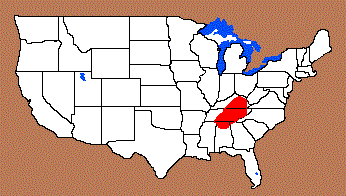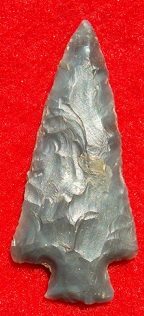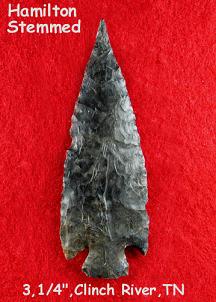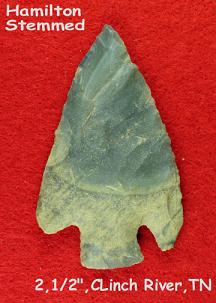Outline is Representative of Size and Shape:


Name Details:
Identified By: James Cambron
Named For: James Cambron
Date Identified: 1975
Type Site:
Comment: Thomas Lewis and Madeline Kneberg first described in 1946
Identified By: James Cambron
Named For: James Cambron
Date Identified: 1975
Type Site:
Comment: Thomas Lewis and Madeline Kneberg first described in 1946
Point Validity:
Valid type
Cambron is a distinguished avocational archaeologist that did extensive work in Alabama and the Tennessee River valley. This point was named in a personally published book. This point has been referred to in numerous professional publications and is considered a valid type.
Hamilton Stemmed
Cluster: Description of Physical Characteristics and Flaking Pattern:
This is a medium (2.5 to 3.5 inches) triangular expanding stem point with an elliptical cross section. The blade is primarily excurvate. A sharp acute distal end may give the blade a recurvate appearance. The shoulders are barbed with an expanding stem. The base may vary from straight to slightly convex and has basal thinning. This point has a random flaking pattern.
Size Measurements:
Total Length - 40 to 110 mm (average 60 to 75 mm), Stem Length - 7 to 10 mm, Max. Blade Width - 24 to 35 mm, Neck Width - 10 to 15 mm, Stem Width - 14 to 19 mm.
Total Length - 40 to 110 mm (average 60 to 75 mm), Stem Length - 7 to 10 mm, Max. Blade Width - 24 to 35 mm, Neck Width - 10 to 15 mm, Stem Width - 14 to 19 mm.
Commonly Utilized Material:
Additional Comments:
This point should not be confused with the Hamilton Concave Base point found in Florida and the Gulf Coastal area. This point is a barbed Woodland point and the Hamilton Concave Base is an Early Archaic point and is part of the Savannah River cluster.
This point should not be confused with the Hamilton Concave Base point found in Florida and the Gulf Coastal area. This point is a barbed Woodland point and the Hamilton Concave Base is an Early Archaic point and is part of the Savannah River cluster.
Distribution:
Distribution Comments:
This point is primarily found in the Tennessee River basin.
This point is primarily found in the Tennessee River basin.
Age / Periods:
Date: 1,600 - 1,000 B.P.
Cultural Period: Woodland
Glacial Period: Roman to Medieval Warm
Culture: Roman to Medieval Warm
Date: 1,600 - 1,000 B.P.
Cultural Period: Woodland
Glacial Period: Roman to Medieval Warm
Culture: Roman to Medieval Warm
Age Details:
Other points in this cluster / Related / Associated Points:
Hamilton Triangle
Hamilton Triangle





